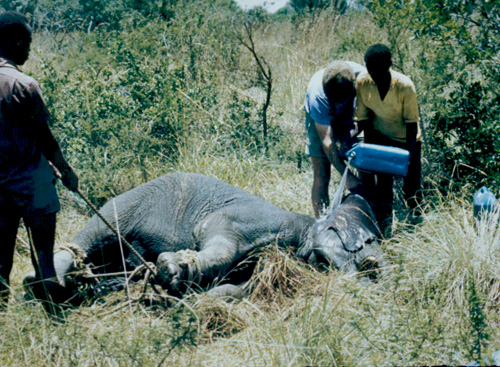The April 22 issue of Maclean’s magazine carried a story by
reporter Sarah Elton about bushmeat. I don’t know if she also came up with the
title, Gorillas in our midst but it
was a nice pun on the Diane Fossey book title
and subsequent movie Gorillas in theMist.
A similar article titled Monkeys on the menu appeared in the April 15
on-line version of the magazine
 |
| A roadside bushmeat vendor in Cameroon. He\is just trying to make a living |
It was good to see this important issue highlighted, but as
someone who has witnessed the bushmeat trade first-hand and written
about it in some detail I found that there were some missing elements that
should have been covered. I wrote the
following letter to the magazine’s editor and in due course received a reply
telling me that it had been forwarded to Ms Elton.
Of course I had the luxury, in my book The Trouble With Lions (U of Alberta Press 2008) of being able to
explore the subject outside the restrictions of the kind of word limit required
in a magazine article, but I believe that the disease issues I raised are
important.
Here is the letter, unedited from what I sent, but with two
of my own pictures slotted in at appropriate spots, as I cannot use the ones from
the magazine.
Dear Mr. Stevenson,
Sarah Elton’s story on bushmeat,
with its clever punning title Gorilla in our midst is, like the curate’s
egg of Punch cartoon fame, good in parts. She misses a few really
important points. I have worked in Africa for many years and also written books
and blogs on the continent’s wildlife. I have three chapters in my book The
Trouble With Lions that cover this subject in some detail. The third one is
titled Bushmeat and Bureaucrats. Like the members of this corps
worldwide it seems that Canadian ones are slow to act.
I realize that Elton was
constrained by a word limit, but the Photoshopped image of the gorilla head on
the meat counter made a nice point and was perhaps a worthy replacement for the
1000 extra words the article needed. She has however either missed out on or is
misinformed about disease risks.
Foot and mouth disease is endemic
in much of Africa and all cloven-hoofed species are susceptible. Canada’s last
outbreak of this economically disastrous plague occurred in Saskatchewan in
1952. It was traced back to the importation of smoked meat from Poland.
Bushmeat from Africa poses at least as great a risk.
Monkey pox is misnamed (not
Elton’s fault). It is a disease of rodents – remember the outbreak in the USA
that was linked to pet gophers in 2003. People in Africa, desperate for protein
are eating species once considered taboo. The Wakamba of Kenya, a tribe famed
as hunters, are amongst them.
 |
| Egyption fruit bats in a cave in Queen Elizabeth NP in Uganda |
Fruit bats, a common bushmeat
item, carry Ebola and the closely related Marburg virus. Both are deadly to
humans. For several years I took senior veterinary students to Uganda and a
highlight was a visit to a cave in Queen Elizabeth National Park that was the
daytime home to an estimated 100,000 bats. That stopped after an unfortunate
Dutch woman who had visited the cave contracted Marburg and died at home in
Holland. The cave is now off-limits to all.
AIDS is a disease that crossed
from primates into humans at least seven times in the 20th
century. There are two main virus types, HIV1 and HIV2.
 |
| A chimp feeding on fruit in Uganda |
Beatrice Hahn, a
professor at the University of Alabama showed that chimpanzees are the source
of HIV1 while sooty mangabeys, a small almost uniformly grey monkey from West
Africa are the source of HIV2. Even more fascinating is that the two viruses in
humans are less closely related to one another than they are to their original
primate hosts.
I realize that in this little
précis I have exceeded the 300-word limit, but I do have lots of other examples
and I also quoted Dr. Brashares in my book. I also have good pictures of those
fruit bats and of a local bushmeat vendor with whom I had a couple of long
chats. He is from rural Cameroon and is just trying to make a living in a
forest region where livestock cannot be raised.
Yours sincerely
Jerry Haigh BVMS, MSc, FRCVS
I signed off using my Professor Emeritus status in the hope that I would be
taken seriously. I just hope that foot-and-mouth disease does not get into
Canada, or indeed North America, through the bushmeat route. This is a real
case of my not wanting to be an accurate prophet.
I have not heard another word,
either from the magazine or the author. Ah well!
